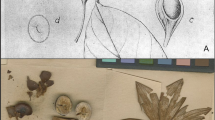Abstract
The genusHomo was established by Carolus Linnaeus in 1758. During the course of the past 150 years, the addition of fossil species to the genusHomo has resulted in a genus that, according to the taxonomic interpretation, could span as much time as 2.5 Myr, and include as many as ten species. This paper reviews the fossil evidence for each of the species involved, and sets out the case for their inclusion inHomo. It suggests that while the case for the inclusion of some species in the genus (e.g.Homo erectus) is well-supported, in the case of two of the species,Homo habilis andHomo rudolfensis, the case for their inclusion is much weaker. Neither the cladistic evidence, nor evidence about adaptation suggest a particularly close relationship with laterHomo.
Similar content being viewed by others
References
Alexeev, V.P. 1986.The origin of the human race. Moscow: Progress Publishers.
Bermudez de Castro, J.M., Arsuaga, J.L., Carbonell, E., Rosas, A., Martinez, I., and Mosqueria, M. 1997.A hominid from the Lower Pleistocene of Atapuerca, Spain: Possible Ancestor to Neandertals and Modern Humans. Science, 276:1392–1395.
Black, D. 1927.On a lower molar hominid tooth from the Chou Kou Tien deposit. Palaeontologicia Sinica, New Series D, 7:1–28.
Brauer, G. 1992.Africa’s place in the evolution of Homo sapiens. In: Continuity and Replacement: controversies inHomo sapiens evolution (eds. Brauer, G. and Smith, F.H.) pp. 83–98. Balkema: Rotterdam.
Brauer, G. 1994.How different are Asian and African Homo erectus? In: 100 years ofPithecanthropus. TheHomo erectus problem (ed. J.L. Franzen), Courier. Forschungs-Institut Senckenberg, 171:301–318.
Brauer, G. and Mbua, E. 1992. Homo erectusfeatures used in cladistics and their variability in Asian and African Hominids. Journal of Human Evolution, 22:79–108.
Brauer, G., Yokoyama, Y., Falgueres, C. and Mbua, E. 1997.Modern human origins backdated. Nature, 386:337–338.
Busk, G. 1865.On a very ancient cranium from Gibraltar. Report of the British Association Advancement of Science, (Bath, 1864):91–92.
Clark, J.D., de Heinzelin, J., Schick, K.D., Hart, W.K., White, T.D., Wolde Gabriel, G., Walter, R.C., Suwa, G., Asfaw, B., Vrba, E. and H. Selassie, Y. 1994.African
Homo erectus:old radiometric ages and young Oldowan assemblages in the Middle Awash Valley, Ethiopia. Science, 264:1907–1910.
Dubois, E. 1892.Palaeontogische anderzoekingen op Java, inVerslag van het Mijnwezen. Batavia, 3:10–14.
Foley, R.A. and Lahr, M.M. 1992.Beyond “out of Africa”: reassessing the origins of Homo sapiens. Journal of Human Evolution, 22:523–529.
Groves, C.P. and Mazák, V. 1975.An approach to the taxonomy of the Hominidae: Gracile Villafranchian hominids of Africa. Casopis Pro Mineralogii A Geologii, 20:225–247.
Hartwig-Schrerer, S., and Martin, R.D. 1991.Was ‘Lucy’ more human than her child? Observations on early hominid postcranial specimens. Journal of Human Evolution, 21:439–449.
Hrdlicka, A. 1927.The Neanderthal phase of man. Journal of the Royal Anthropological Institute, 57:249–274.
Hublin, J.J., Ruiz, C.B., Lara, P.M., Fontugne, M., and Reyss, J.-L. 1995.The Mousterian site of Zafarraya (Andalucia, Spain): dating and implications of the peopling processes of Western Europe. Comptes Rendus Academie des Sciences Paris (Series II a), 321:931–937.
Jelínek, J. 1978. Homo erectusor Homo sapiens? Recent advances in Primatology, 3:419–429.
Keith, A. 1912.Ancient Types of Man. Harper: London and New York.
Kennedy, G.E. 1999.Is “Homo rudolfensis”a valid species? Journal of Human Evolution, 36:
King, W. 1864.The reputed fossil man of the Neanderthal. Quarterly Journal of Science, 1:88–97.
Kramer, A. 1993.Human taxonomic diversity in the Pleistocene: does Homo erectusrepresent multiple hominid species? American Journal of Physical Anthropology, 91:161–171.
Lahr, M.M. and Foley, R.A. 1994.Multiple dispersals and modern human origins. Evolutionary Anthropology, 3(2):48–60.
Leakey, L.S.B., Tobias, P.V., and Napier, J.R. 1964.A new species of the genus Homofrom Olduvai Gorge. Nature, 202:7–9.
Le Gros Clark, W.E. 1955.The fossil evidence for Human Evolution. University of Chicago Press: Chicago.
Linnaeus, C. 1758.Systema Naturae. Laurentii Salvii: Stockholm.
Mayr, E. 1944.On the concepts and terminology of vertical subspecies and species. National Research Council Bulletin, 262:11–16.
Mayr, E. 1950.Taxonomic categories in fossil hominids. Cold Spring Harbor Symposia on Quantitative Biology, 15:109–118.
Schmerling, P.C. 1833.Recherches sur des ossements fossiles decouverts dans les cavernes de la province de Liege, Liege, pp. 59–62.
Schoetensack, O. 1908.Der Unterkiefer des Homo heidelbergensisaus den Sanden von Mauer bei Heidelberg. Leipzig, 1908:1–6.
Semaw, S., Renne, P., Harris, J.W.K., Feibel, C.S., Bernor, R.L., Fesseha, N. and Mowbray, K. 1997.2.5-million-year-old stone tools from Gona, Ethiopia. Nature, 385:333–336.
Thorne, A., Grün, R., Martinez, G. N.A., Simpson, J.J., McCulloch, M., Taylor, L. and Curnoe, D.Australia’s oldest human remains: age of the Lake Mungo 3 skeleton. Journal of Human Evolution, 36:591–612.
Topinard, P. 1890.Anthropology. Chapman and Hall: London.
Turner, A. and Chamberlain, A.T. 1989.Speciation, morphological change and the status of African Homo erectus. Journal of Human Evolution, 18:115–130.
Wolpoff, M.H., Thorne, A.G., Jelinek, J. and Zhang, Y. 1994.The case for sinking Homo erectus. 100 years of Pithecanthropus is enough. Courier Forschungs-Institut Senckenberg, 171:341–361.
Wood, B.A. 1992.Origin and evolution of the genus Homo. Nature, 355:783–790.
Wood, B.A. 1994.Taxonomy and evolutionary relationships of Homo erectus. Courier Forschungs-Institut Senckenberg, 171:159–165.
Wood, B.A. 1999. ‘Homo rudolfensis’Alexeev, 1986 — fact or phantom? Journal of Human Evolution, 36:115–118.
Wood, B. and Collard, M. 1999a.The Human Genus. Science, 284:65–71.
Wood, B. and Collard, M. 1999b.The changing face of Homo. Evolutionary Anthropology, in press.
Woodward, A.S. 1938.A fossil skull of an ancestral Bushman from the Anglo-Egyptian Sudan. Antiquity, 12:193–195.
Author information
Authors and Affiliations
Rights and permissions
About this article
Cite this article
Wood, B.A. The history of the genusHomo . Hum. Evol. 15, 39–49 (2000). https://doi.org/10.1007/BF02436233
Issue Date:
DOI: https://doi.org/10.1007/BF02436233




